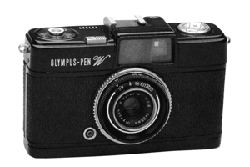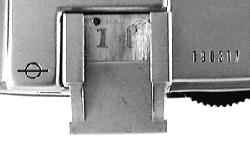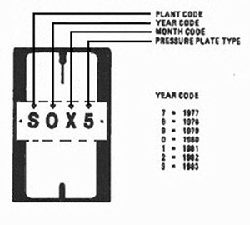
the cornucopia
is this the last olympus pen wide?
copyright the olympus circle/john foster

the cornucopia is this the last olympus pen wide? copyright the olympus circle/john foster |

Pen Wide held in the Olympus Archives |
INTRODUCTION: This is a small but hopefully interesting article written for Quest, the Magazine of The Olympus Circle. This appeared in the March 2005 issue (No 7) and draws on further research done following publication of the Viewfinder Pen Book into the desirable Pen Wide production pattern and numbers manufactured. ~~~~~ It is well known we can date V/F Pens but why should we? For me a large part of collecting is knowing how old my examples are and how early they are in the series. Amongst collectors is there anyone who would not like to own the earliest or last example of a particular model? Itís all part of the appeal of collecting. Having an early example in a series can be very illuminating especially when you compare it to any later ones you may have. I learned a lot about my collection by comparing them in this way. But doesnít the serial number tell us much the same thing? Not quite. Serial numbers are a simple progression of a numbering system over production time. A single serial number tells us a little, but if it is correlated with a date code it can tell us much more. But there is a problem with serial numbers; for many reasons a camera might be fitted with a new top or bottom plate thus removing its authenticity. For researchers like me this presents problems when trying to put together a sequence of production within a series. Having the serial number and date code correlated makes it much easier to spot the oddity in a range of collected data. In turn being able to remove such oddities is essential for research into production patterns where the company will not release production information. And of course, it is possible to determine whether your example is completely authentic, also very useful when researching early models. Does Olympus date code its products? In the main the simple answer is yes. Certainly the V/F Pen series is dated throughout its life span of 25 years, though the date code marking and position change over time. Early Pens and those fitted with an accessory shoe have the date code machine stamped or hand written on the aluminium block exposed when the shoe cover is removed. Later Pens or ones without shoes have the code on the reverse of the film pressure plate. Both are reasonably easy to observe, requiring only a little dexterity. Date codes are a collection of numbers, letters and hieroglyphics, some hand written in china-graph pencil and others machine printed. |

Viewfinder Pen camera hidden date code |
What does the code tell us? Depending on the series it tells us the month and year of production and in some cases the factory where it was made. Codes follow the American format where the first number equates to the year, and the second to the month of production. There should be two numbers, or a number and a letter and in some cases an additional hieroglyphic meaning year, month and factory. Where, as in the case of some viewfinder Pens, the production might span a decade or more, all this information is useless unless we have the overall production run. There is normally some received wisdom relating to production periods available from general sources. But as regards the real question, that is numbers made, Olympus is generally silent. This being so, sound data such as correct correlation between date code and serial numbers is essential. |

Read codes from Olympus technical literature |
We can use the information from Pen cameras along side published production periods to study the production pattern of a model. We can also use combinations of date codes, serial numbers and production periods to predict numbers made where this is unknown. Or we can use simple maths to predict any missing part of the total information we would like to have. I found the most accurate predictions made with my collected research data related to very short runs and low number models such as the Pen Wide. In the case of Pen Wide the mathematical or statistical prediction of numbers made was 20,088. The production numbers when released show total Pen Wide production to be 21,077 pieces. My figures were 989 adrift, an error of less than 5%. Although I had a surprising amount of Pen Wide data, the self same prediction could have been made with good data from as little as 4 or 5 cameras. In conclusion, it is interesting to note that the Pen W held in the Olympus archives, the one that appears in most published material about the camera, is almost certain to be the last Pen Wide made. Its serial number is 121327 making it 21,327th off the line. The difference between the last number made (or more correctly fit for sale) and the number produced is 21327 Ė 21077 = 250; this figure is likely to represent line losses. This in itself is an interesting statistic for nowhere in general reading is mention made of line loss, but such losses are inevitable. Using these figures the percentage line loss is calculated at a tad over 1.1 percent. Manipulating even small amounts of data enables the researcher to present a plausible and quite accurate account of an unrecorded production process that occurred decades ago. Thanks to John Foster, Editor, Quest (author) and the Executive Committe of The Olympus Circle in whom copyright vests. |
|
|
|
HOME |
INTRO |
BOOKS |
OLYMPUS CIRCLE |
QUEST |
TOC MEMBERS |
GALLERIES
|
| Posted 06/06/2005 | Copyright © 2005 John Foster |